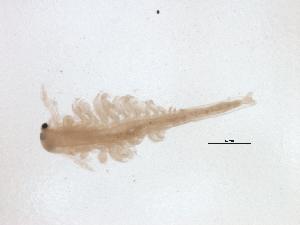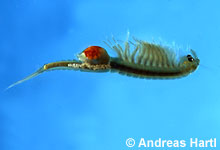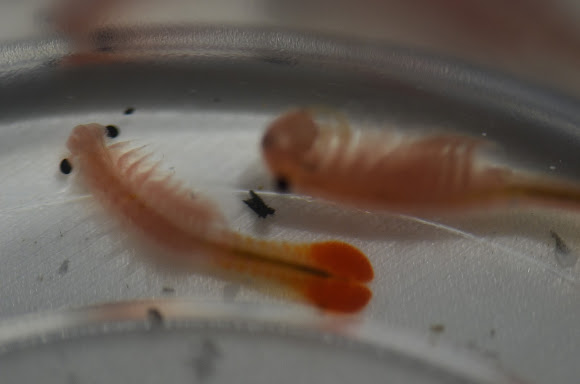Post by myths on Mar 31, 2019 6:59:16 GMT
The term fairy shrimp encompasses a fairly diverse group of animals and even includes the brine shrimp families contrary to popular misconception.
Without getting too deep on the scientific classification, let's take a closer look at the Anostraca; which is divided up into 8 major families totaling well over 300 individual species.
As hobbyists, we primarily encounter 3 of the families. We'll take a look at those first.
Branchinecta

![]()

![]()
This genus contains about 50 species of fairy shrimp and includes a lot of the eggs we find in sale and trade circles. Examples include the vernal pool fairy shrimp (Branchinecta lynchi), winter fairy shrimp (Branchinecta hiberna) and the legendary giant fairy shrimp (Branchinecta gigas).
Streptocephalus

This genus contains close to 70 species and examples can be found in the Americas, Africa, Australia, and Eurasia. Examples here include the spiny tail fairy shrimp (Streptocephalus sealii), and the gorgeous blue and orange Streptocephalus siamensis; a species discovered only 10 years ago. Most of the fairy shrimp species coming out of Asia/ Thailand fall into the Streptocephalus genus.
Artemiidae

This represents the brine shrimp (artemia), a group of about 9 species the world over, the most common of these being Artemia salina (common brine shrimp) and the hybrid Artemia nyos (Sea Monkey).
Best of the rest.
The remaining 5 genus break down as follows and may actually be more common for you depending on what part of the globe you call home.
Branchipodidae

There were once 40 species in this group but now only 5 remain. The few that do are commonly found in rock pools at high elevations such as those in the mountains of Africa. Eggs of these species aren't commonly listed.
Chirocephalidae

There are some 110+ species in this family and to look at them, it's tricky to discern them from the more common Branchinecta or Streptocephalus. The differences, as scientists observed and cataloged, are reduced or vestigial maxilla, more than two setae on the fifth endite; things you really can't observe by looking without a microscope. They are commonly found around Europe.
Parartemia

This genus of 18 species is found exclusively on the continent of Australia. Though fairly common in the vernal pools there, it's rare to find many of their eggs on the international market.
Tanymastigidae

Representing the loneliest family of the lot, Tanymastigidae consists of only about 4 total species around the globe. They are typically found in Europe and North Africa and are known for having lentil-shaped legs. Extremely rare to encounter their eggs for sale in any capacity.
Thamnocephalidae

Once actually included in the Branchipodidae family, Thamnocephalidae proved over time to be worthy of its own unique family and includes close to 50 species. Their distribution includes Western Australia and Southern Africa. There is one popular member of this family traded commercially in the Beavertail Fairy Shrimp.
Without getting too deep on the scientific classification, let's take a closer look at the Anostraca; which is divided up into 8 major families totaling well over 300 individual species.
As hobbyists, we primarily encounter 3 of the families. We'll take a look at those first.
Branchinecta


This genus contains about 50 species of fairy shrimp and includes a lot of the eggs we find in sale and trade circles. Examples include the vernal pool fairy shrimp (Branchinecta lynchi), winter fairy shrimp (Branchinecta hiberna) and the legendary giant fairy shrimp (Branchinecta gigas).
Streptocephalus

This genus contains close to 70 species and examples can be found in the Americas, Africa, Australia, and Eurasia. Examples here include the spiny tail fairy shrimp (Streptocephalus sealii), and the gorgeous blue and orange Streptocephalus siamensis; a species discovered only 10 years ago. Most of the fairy shrimp species coming out of Asia/ Thailand fall into the Streptocephalus genus.
Artemiidae

This represents the brine shrimp (artemia), a group of about 9 species the world over, the most common of these being Artemia salina (common brine shrimp) and the hybrid Artemia nyos (Sea Monkey).
Best of the rest.
The remaining 5 genus break down as follows and may actually be more common for you depending on what part of the globe you call home.
Branchipodidae

There were once 40 species in this group but now only 5 remain. The few that do are commonly found in rock pools at high elevations such as those in the mountains of Africa. Eggs of these species aren't commonly listed.
Chirocephalidae

There are some 110+ species in this family and to look at them, it's tricky to discern them from the more common Branchinecta or Streptocephalus. The differences, as scientists observed and cataloged, are reduced or vestigial maxilla, more than two setae on the fifth endite; things you really can't observe by looking without a microscope. They are commonly found around Europe.
Parartemia
This genus of 18 species is found exclusively on the continent of Australia. Though fairly common in the vernal pools there, it's rare to find many of their eggs on the international market.
Tanymastigidae

Representing the loneliest family of the lot, Tanymastigidae consists of only about 4 total species around the globe. They are typically found in Europe and North Africa and are known for having lentil-shaped legs. Extremely rare to encounter their eggs for sale in any capacity.
Thamnocephalidae
Once actually included in the Branchipodidae family, Thamnocephalidae proved over time to be worthy of its own unique family and includes close to 50 species. Their distribution includes Western Australia and Southern Africa. There is one popular member of this family traded commercially in the Beavertail Fairy Shrimp.

